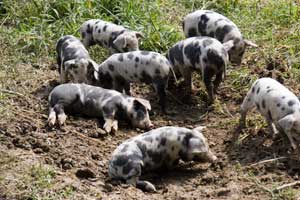About Wild Pigs
History of Wild Pigs
Wild pigs were brought to the Americas by early Spanish explorers. They were a popular livestock animal for early settlers and spread throughout the southeastern U.S. Today, wild pigs can be found in 45 states, having been transported into northern states largely by humans for hunting purposes. Learn more about the history of wild pigs in the United States.
 Wild Pigs Wallowing
Wild Pigs Wallowing
Behavior and Biology of Wild Pigs
Wild or feral pigs are highly adaptable, making them capable of living in a variety of temperatures, climates, and conditions. They eat almost anything - making them opportunistic omnivores. These animals can reproduce rapidly, another factor leading to their widespread populations. There are few, if any, predators for this species other than man. Learn more about the behavior and biology of feral pigs.
Signs of Wild Pigs
The most obvious sign of the presence of wild hogs on your property is damage to crops, fields, trees, or soil. Pigs dig up soil when rooting for food. They also wallow is wet soil to cool off. Sometimes, you can see wooden stakes or trees that have been rubbed by wild pigs. Learn about more field signs of the presence of wild pigs.

